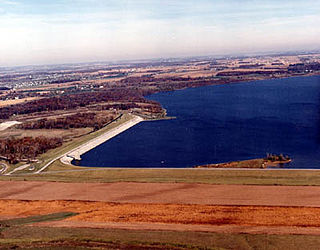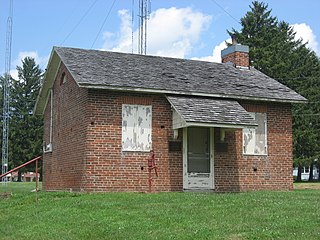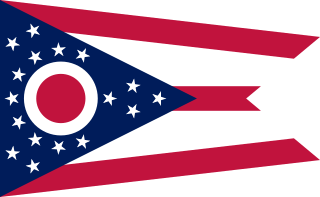
Abraham Lincoln Birthplace National Historical Park preserves two separate farm sites in LaRue County, Kentucky where Abraham Lincoln was born and lived early in his childhood. He was born at the Sinking Spring site south of Hodgenville and remained there until the family moved to the Knob Creek Farm northeast of Hodgenville when he was 2 years old, living there until he was 7 years old. The Sinking Spring site is the location of the park visitors center.

Cumberland Mountain State Park is a state park in Cumberland County, Tennessee, in the southeastern United States. The park consists of 1,720 acres (7.0 km2) situated around Byrd Lake, a man-made lake created by the impoundment of Byrd Creek in the 1930s. The park is set amidst an environmental microcosm of the Cumberland Plateau and provides numerous recreational activities, including an 18-hole Bear Trace golf course.

Lincoln Boyhood National Memorial is a United States Presidential Memorial, a National Historic Landmark District in present-day Lincoln City, Indiana. It preserves the farm site where Abraham Lincoln lived with his family from 1816 to 1830. During that time, he grew from a 7-year-old boy to a 21-year-old man. His mother, Nancy Hanks Lincoln, and at least 27 other settlers were buried here in the Pioneer Cemetery. His sister Sarah Lincoln Grigsby was buried in the nearby Little Pigeon Baptist Church cemetery, across the street at Lincoln State Park.

Knob Creek Farm has been a non-contiguous section of the Abraham Lincoln Birthplace National Historical Park since 2001; prior to that date it was privately owned. From 1811 to 1816, it was the childhood homestead of the future President of the United States Abraham Lincoln, who said it was his "earliest recollection". The site consists of four buildings, two of which are historical in nature.

Watters Smith Memorial State Park is a 532-acre (2.15 km2) historical park and national historic district with a pioneer homestead and museum located in Harrison County, West Virginia. The homestead, rising above Duck Creek, is a memorial to settler Watters Smith, who was born in Trenton, New Jersey, in 1767, and moved to Harrison County in what was then Virginia, in 1796, with his wife Elizabeth Davisson Smith. A log cabin similar to the original was moved and reconstructed on the park, together with farm buildings typical of early 19th century settlement. The more modern Smith family home has been restored as a museum, and an additional museum houses many local farm artifacts from earlier eras. Guided tours are offered from Memorial Day weekend through Labor Day. In addition, the park features swimming, picnicking, hiking trails, and horseback riding.

Harker's Run is a stream originating in Preble County, Ohio. Harker's Run drains into Four Mile Creek on the eastern edge of the campus of Miami University in Oxford just north of where the Trenton Oxford Road crosses Four Mile/Talawanda Creek. The stream flows roughly from north to south, and is approximately 5.5 miles (8.9 km) in total length. The elevation at the mouth of the stream is 775 feet (236 m) above sea level. At its highest point, the stream is at approximately 1,000 feet (305 m) elevation. The stream is crossed by bridges on Bonham Road, Somerville Road, Hamilton Richmond Road, and Oxford Germantown Road.

Hunting Lodge Farm is a historic house located near Oxford in Oxford Township, Butler County, Ohio, United States. Constructed as a hunting lodge, it has been used by multiple prominent local residents, and its distinctive architecture has made it worthy of designation as a historic site.

The Arnold Homestead is a historic homestead in the city of Huber Heights, a suburb of Dayton, Ohio, United States. Formed at the turn of the nineteenth century, it centers on an 1830s farmhouse that was built for an immigrant family from Virginia.

The William H. McGuffey Boyhood Home Site is a National Historic Landmark in Mahoning County, Ohio. It is the location where William H. McGuffey (1800-1873), lived for much of his youth. McGuffey is best known as the creator of the McGuffey Readers, a hugely popular set of educational primers. The site, now a regional park known as the McGuffey Wildlife Preserve, was designated a National Historic Landmark in 1966.

The dogtrot, also known as a breezeway house, dog-run, or possum-trot, is a style of house that was common throughout the Southeastern United States during the 19th and early 20th centuries. Some theories place its origins in the southern Appalachian Mountains. Some scholars believe the style developed in the post-Revolution frontiers of Kentucky and Tennessee. Others note its presence in the low country of the Carolinas from an early period. The main style point was a large breezeway through the center of the house to cool occupants in the hot southern climate.

The Cunningham Cabin is a double-pen log cabin in Grand Teton National Park. The cabin was built as a homestead in Jackson Hole and represents an adaptation of an Appalachian building form to the West. The cabin was built just south of Spread Creek by John Pierce Cunningham, who arrived in Jackson Hole in 1885 and subsisted as a trapper until he established the Bar Flying U Ranch in 1888. The Cunninghams left the valley for Idaho in 1928, when land was being acquired for the future Grand Teton National Park.

The Buckner Homestead Historic District, near Stehekin, Washington in Lake Chelan National Recreation Area incorporates a group of structures relating to the theme of early settlement in the Lake Chelan area. Representing a time period of over six decades, from 1889 to the 1950s, the district comprises 15 buildings, landscape structures and ruins, and over 50 acres (200,000 m2) of land planted in orchard and criss-crossed by hand-dug irrigation ditches. The oldest building on the farm is a cabin built in 1889. The Buckner family bought the farm in 1910 and remained there until 1970, when the property was sold to the National Park Service. The Buckner Cabin was listed on the National Register of Historic Places in 1974. The rest of the Buckner farm became a historic district in 1989. Today, the National Park Service maintains the Buckner homestead and farm as an interpretive center to give visitors a glimpse at pioneer farm life in the Stehekin Valley.

Buck Creek State Park is a 4,016-acre (1,625 ha) Ohio state park in Clark County, Ohio in the United States, around part of Buck Creek. The park is leased by the state of Ohio from the U.S. Army Corps of Engineers. It includes C. J. Brown Reservoir and Dam, a flood control dam and reservoir built by the USACE as part of a flood control system in the Ohio River drainage basin. Buck Creek State Park is open for year-round recreation including camping, boating, hunting, fishing, swimming, picnicking and hiking.

The Studabaker-Scott House and Beehive School are two historic buildings near the city of Greenville in Darke County, Ohio, United States. Located along State Route 49 south of the city, both are unusually well-preserved remnants of the architecture of the middle third of the nineteenth century.

Lower Swedish Cabin is an historic Swedish-style log cabin on Creek Road in Drexel Hill, Pennsylvania, along Darby Creek. The cabin may be one of the oldest log cabins in the United States.

The Chris Jorgensen Studio is a one-room log building, built in 1904 as an artist's studio for Chris Jorgensen in the Yosemite Valley. Jorgensen, an instructor and assistant director of the California School of Fine Arts, arrived in Yosemite in the 1890s. Jorgensen studied and depicted local Native Americans from 1899, collecting native basketwork. The National Park Service acquired the Jorgensen Studio in 1919, calling it the Yosemite Museum. Jorgensen donated his basket collection to the museum in 1923. Jorgensen's widow, Angela Ghiardelli, donated many of Jorgensen's works to the museum following his death in 1935.

Little Pigeon Creek Community, also known as Little Pigeon Creek Settlement and Little Pigeon River settlement, was a settlement in present Carter and Clay Townships, Spencer County, Indiana along Little Pigeon Creek. The community, in the area of present-day Lincoln City, Indiana, was established from frontier land by 1816. There were sufficient settlers to the Indiana wilderness that it became a state in December, 1816.

Lincoln Pioneer Village is a memorial along the Ohio River in Rockport, Spencer County, Indiana to President Abraham Lincoln who lived in the county during his boyhood years. It was built in 1934 and 1935 in the city park by the Works Progress Administration. George Honig, an artist and sculptor from Spencer County, designed the memorial. He also oversaw the building of the pioneer village replica, which was sponsored by the Spencer County Historical Society and the Rockport City Council. It was listed as a historic district on the National Register of Historic Places on April 20, 1998.

The Stone Wall Ranch, also known as the Reader or Rasmussen Ranch, is a ranch in the Little Snake River valley of Carbon County, Wyoming, about 1.5 miles (2.4 km) from Savery. It was established by Noah and Hosannah Reader in 1871, the first permanent homestead in the valley. A temporary winter shelter was built in the winter of 1871-72, followed by a permanent structure in 1872-73 that survives in the ranch complex. The ranch was named for a nearby sandstone escarpment.




























